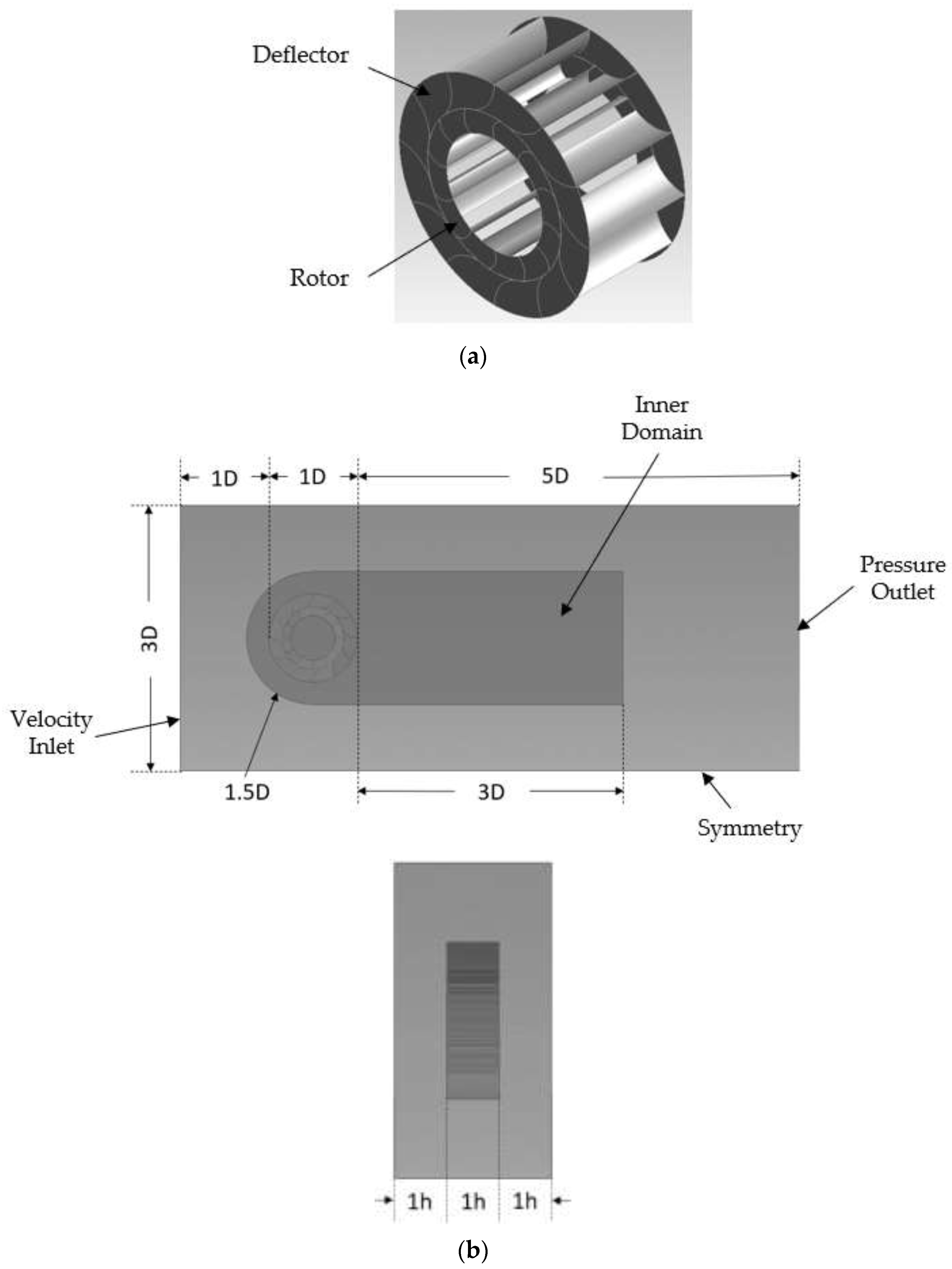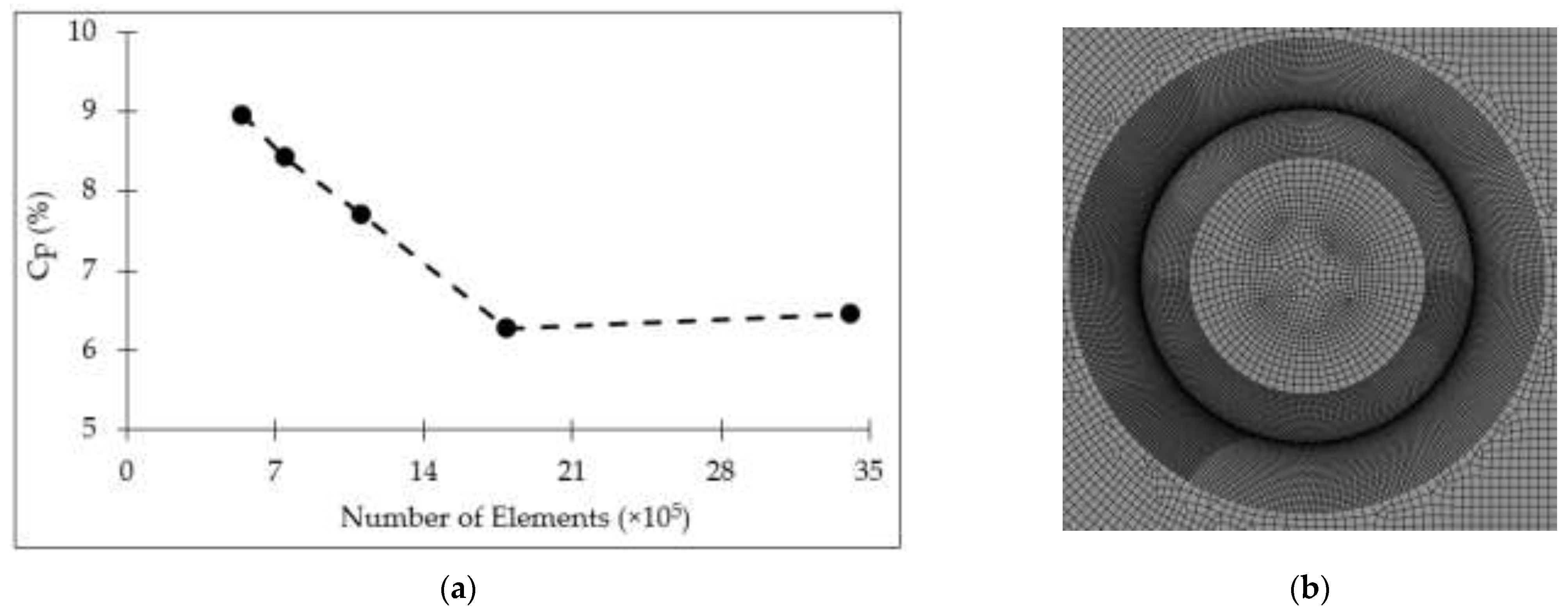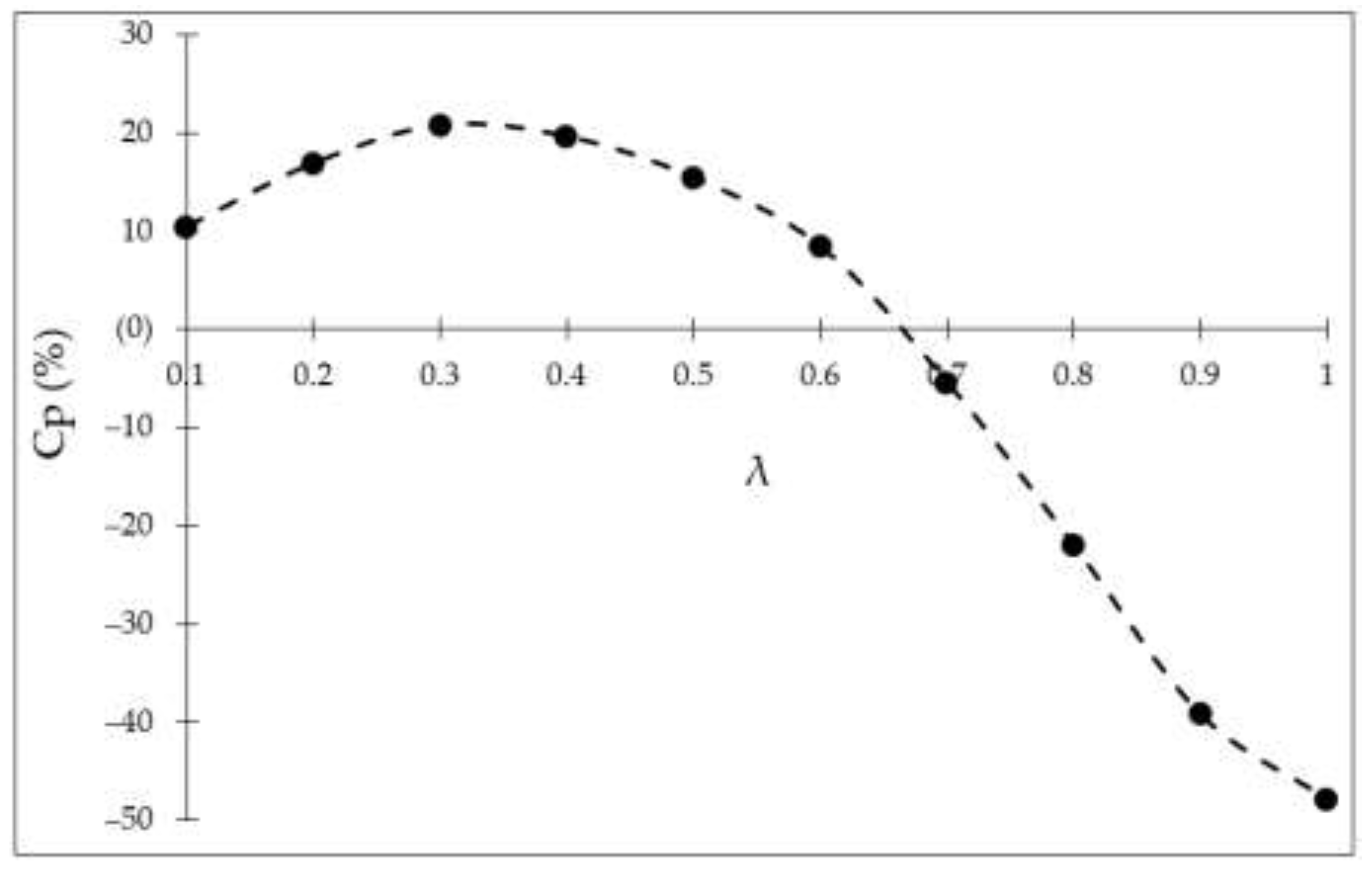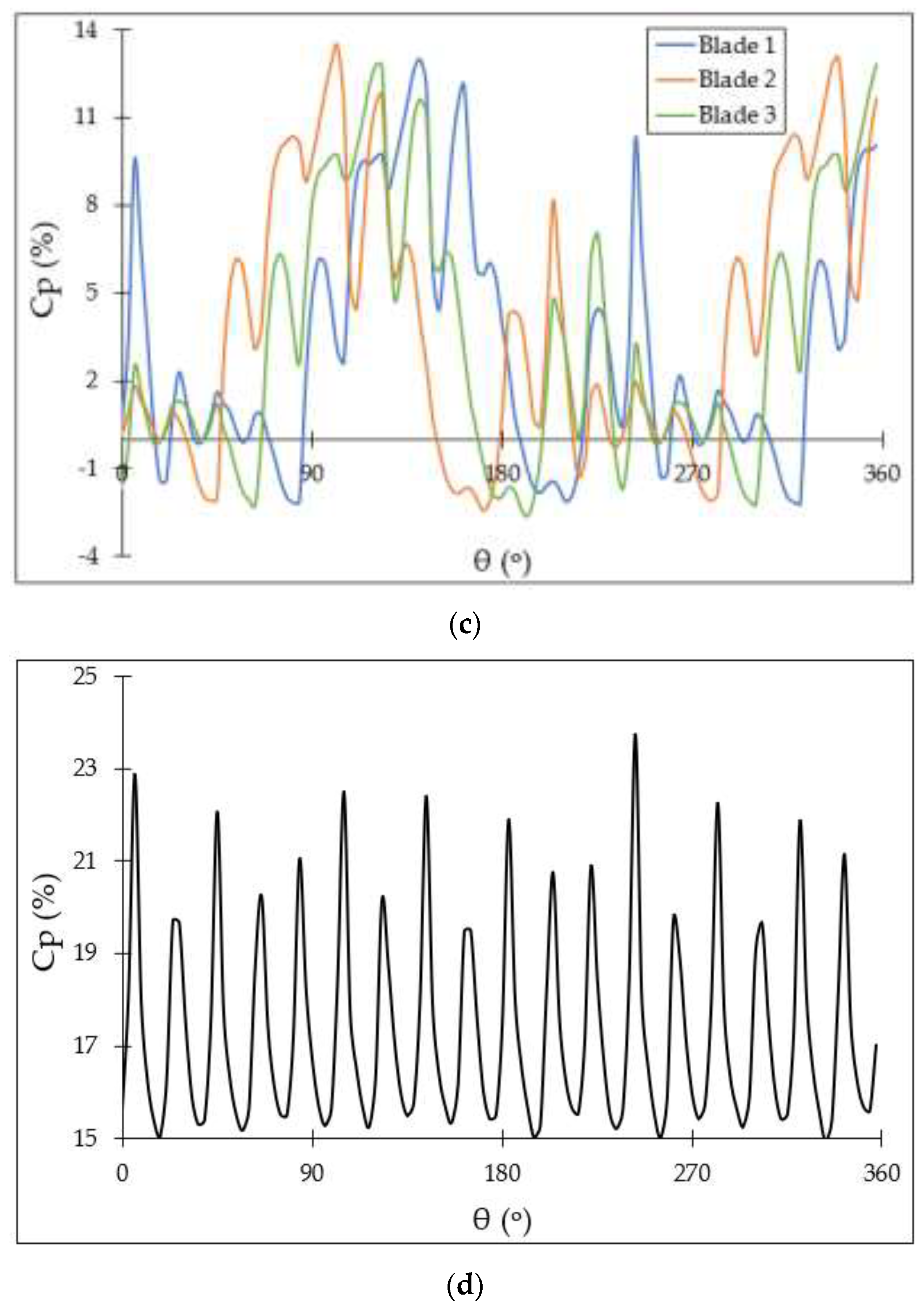Numerical Investigations on the Transient Aerodynamic Performance Characterization of a Multibladed Vertical Axis Wind Turbine
Abstract
1. Introduction
2. Numerical Modeling of the Multibladed VAWT
2.1. Geometry of the Multibladed VAWT and the Flow Domain
2.2. Meshing of the Flow Domain
2.3. Boundary Conditions and Turbulence Modeling
2.4. Validation of the Numerical Model
3. Steady-State Aerodynamic Characterization
4. Transient Aerodynamic Characterization
5. Conclusions
Author Contributions
Funding
Data Availability Statement
Conflicts of Interest
References
- Scottish Government. Energy Statistics for Scotland. 2022. Available online: https://www.gov.scot/publications/energy-statistics-for-scotland-q4-2022/#:~:text=March%202023-,Key%20Points,figure%20to%20date%2C%20overtaking%202020. (accessed on 12 November 2023).
- Commons, C.; Winslow, A. Clark University. 2017. Available online: https://commons.clarku.edu/cgi/viewcontent.cgi?article=1158&context=idce_masters_paperp. (accessed on 19 December 2023).
- Wong, K.H.; Chong, W.T.; Sukiman, N.L.; Poh, S.C.; Shiah, Y.C.; Wang, C.T. Performance enhancements on vertical axis wind turbines using flow augmentation systems: A review. Renew. Sustain. Energy Rev. 2017, 73, 904–921. [Google Scholar] [CrossRef]
- Gerrie, C.; Islam, S.Z.; Gerrie, S.; Turner, N.; Asim, T. 3D CFD Modelling of Performance of a Vertical Axis Turbine. Energies 2023, 16, 1144. [Google Scholar] [CrossRef]
- Beller, C.; Urban Wind Energy—State of the Art 2009. Technical Report. National Laboratories for Sustainable Energy. Technical University of Denmark. 2009. Available online: https://www.google.com/url?sa=t&rct=j&q=&esrc=s&source=web&cd=&ved=2ahUKEwij_Ira6YqDAxU0UkEAHZvWBUQQFnoECA0QAQ&url=https%3A%2F%2Forbit.dtu.dk%2Ffiles%2F3947129%2Fris-r-1668.pdf&usg=AOvVaw0zrECDfqtG74fmdVu84020&opi=89978449. (accessed on 6 December 2023).
- Balduzzi, F.; Bianchini, A.; Carnevale, E.A.; Ferrari, L.; Magnani, S. Feasibility analysis of a Darrieus vertical-axis wind turbine installation in the rooftop of a building. Appl. Energy 2012, 97, 921–929. [Google Scholar] [CrossRef]
- Deng, W.; Liu, L.; Guo, Y.; Li, H. Effect of helical twist angle on the aerodynamic performance and blade dynamic characteristics of floating vertical axis wind turbines. Mar. Struct. 2022, 83, 103172. [Google Scholar] [CrossRef]
- Elsakka, M.M.; Ingham, D.B.; Ma, L.; Pourkashanian, M. CFD analysis of the angle of attack for a vertical axis wind turbine blade. Energy Convers. Manag. 2019, 182, 154–165. [Google Scholar] [CrossRef]
- Subramanian, A.; Yogesh, A.; Sivanandan, H.; Giri, A.; Vasudevan, M.; Mugundhan, V.; Velamati, R.K. Effect of airfoil and solidity on performance of small-scale vertical axis wind turbine using three dimensional CFD model. Energy 2017, 133, 179–190. [Google Scholar] [CrossRef]
- Fatahian, H.; Mishra, M.; Jackson, F.F.; Fatahian, E. Design optimization of an innovative deflector with bleed jets to enhance the performance of dual Savonius turbines using CFD-Taguchi method. Energy Convers. Manag. 2023, 296, 117655. [Google Scholar] [CrossRef]
- Ushiyama, I.; Nagai, H.; Shinoda, J. Experimentally Determining the Optimum Design Configuration for Savonius Rotors. Int. J. Ser. B-Fluids Therm. Eng. 1986, 29, 4130. [Google Scholar]
- Asim, T.; Islam, S.Z. Effects of Damaged Rotor on Wake Dynamics of Vertical Axis Wind Turbines. Energies 2021, 14, 7060. [Google Scholar] [CrossRef]
- Colley, G. Design, Operation and Diagnostics of a Vertical Axis Wind Turbine. Ph.D. Thesis, University of Huddersfield, Huddersfield, UK, 2012. [Google Scholar]
- Asim, T.; Singh, D.; Siddiqui, M.S.; McGlinchey, D. Effect of Stator Blades on the Startup Dynamics of a Vertical Axis Wind Turbine. Energies 2022, 15, 8135. [Google Scholar] [CrossRef]
- Cheng, S.; Elgendi, M.; Lu, F.; Chamorro, L.P. On the Wind Turbine Wake and Forest Terrain Interaction. Energies 2021, 14, 7204. [Google Scholar] [CrossRef]
- Elgendi, M.; AlMallahi, M.; Abdelkhalig, A.; Selim, M.Y.E. A review of wind turbines in complex terrain. Int. J. Thermofluids 2023, 17, 100289. [Google Scholar] [CrossRef]
- Liu, C.; Zheng, X.; Sung, C.H. Preconditioned Multigrid Methods for Unsteady Incompressible Flows. J. Comput. Phys. 1998, 139, 35–57. [Google Scholar] [CrossRef]
- Menter, F.L. Zonal Two Equation k-ω Turbulence Models for Aerodynamic Flows. Am. Inst. Aeronaut. Astronaut. 1993, 2906. [Google Scholar]
- Mahmoud, N.H.; El-Haroun, A.A.; Wahba, E.; Nasef, M.H. An experimental study on improvement of Savonius rotor performance. Alex. Eng. J. 2012, 51, 19–25. [Google Scholar] [CrossRef]








| Mesh | Element Size in the VAWT (mm) | Element Size in the Inner Region (mm) | Element Size in the Outer Region (mm) | Total Number of Mesh Elements (×105) |
|---|---|---|---|---|
| 1 (coarsest) | 8 | 24 | 100 | 5.41 |
| 2 | 7 | 21 | 100 | 7.42 |
| 3 | 6 | 18 | 100 | 11.01 |
| 4 | 5 | 15 | 100 | 17.89 |
| 5 (finest) | 4 | 12 | 100 | 34.06 |
Disclaimer/Publisher’s Note: The statements, opinions and data contained in all publications are solely those of the individual author(s) and contributor(s) and not of MDPI and/or the editor(s). MDPI and/or the editor(s) disclaim responsibility for any injury to people or property resulting from any ideas, methods, instructions or products referred to in the content. |
© 2024 by the authors. Licensee MDPI, Basel, Switzerland. This article is an open access article distributed under the terms and conditions of the Creative Commons Attribution (CC BY) license (https://creativecommons.org/licenses/by/4.0/).
Share and Cite
Christie, J.; Lines, T.; Simpson, D.; Asim, T.; Siddiqui, M.S.; Islam, S.Z. Numerical Investigations on the Transient Aerodynamic Performance Characterization of a Multibladed Vertical Axis Wind Turbine. Energies 2024, 17, 1900. https://doi.org/10.3390/en17081900
Christie J, Lines T, Simpson D, Asim T, Siddiqui MS, Islam SZ. Numerical Investigations on the Transient Aerodynamic Performance Characterization of a Multibladed Vertical Axis Wind Turbine. Energies. 2024; 17(8):1900. https://doi.org/10.3390/en17081900
Chicago/Turabian StyleChristie, Jamie, Thomas Lines, Dillon Simpson, Taimoor Asim, Muhammad Salman Siddiqui, and Sheikh Zahidul Islam. 2024. "Numerical Investigations on the Transient Aerodynamic Performance Characterization of a Multibladed Vertical Axis Wind Turbine" Energies 17, no. 8: 1900. https://doi.org/10.3390/en17081900
APA StyleChristie, J., Lines, T., Simpson, D., Asim, T., Siddiqui, M. S., & Islam, S. Z. (2024). Numerical Investigations on the Transient Aerodynamic Performance Characterization of a Multibladed Vertical Axis Wind Turbine. Energies, 17(8), 1900. https://doi.org/10.3390/en17081900









